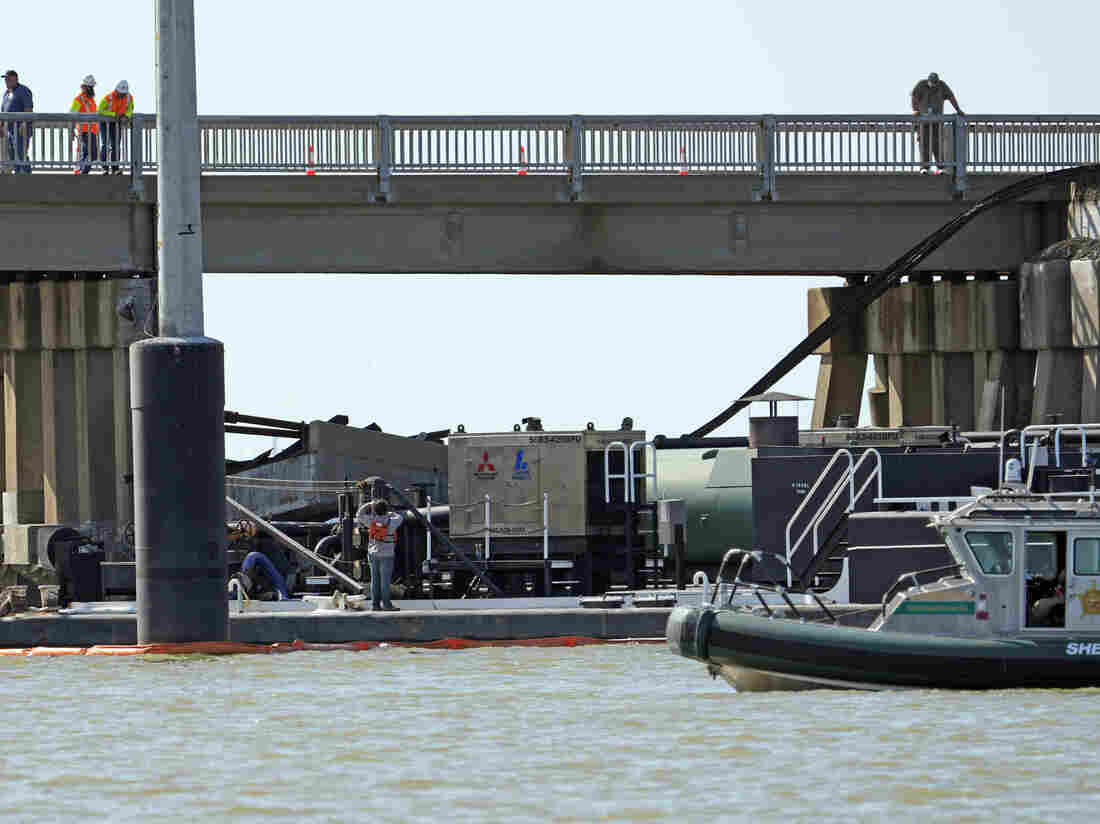National
Barge hits bridge connecting Galveston and Pelican Island, causing oil to spill
Workers survey the site where a barge crashed into the Pelican Island Bridge, on Wednesday in Galveston, Texas.
David J. Phillip/AP
hide caption
toggle caption
David J. Phillip/AP
Workers survey the site where a barge crashed into the Pelican Island Bridge, on Wednesday in Galveston, Texas.
David J. Phillip/AP
GALVESTON, Texas — A barge slammed into a bridge pillar in Galveston, Texas, on Wednesday, spilling oil into waters near busy shipping channels and closing the only road to a small neighboring island. No injuries were reported.
The impact sent pieces of the bridge, which connects Galveston to Pelican Island, tumbling on top of the barge and shut down a stretch of waterway so crews could clean up the spill. The accident knocked one man off the vessel and into the water, but he was quickly recovered and was not injured, said Galveston County Sheriff’s Office Maj. Ray Nolen.
Ports along the Texas coast are hubs of international trade, but experts said the collision was unlikely to result in serious economic disruptions since it occurred in a lesser-used waterway. The island is on the opposite side of Galveston Island’s beaches that draw millions of tourists each year.
The accident happened shortly before 10 a.m. after a tugboat operator pushing two barges lost control of them, said David Flores, a bridge superintendent with the Galveston County Navigation District.
“The current was very bad, and the tide was high,” Flores said. “He lost it.”
Pelican Island is only a few miles wide and is home to Texas A&M University at Galveston, a large shipyard and industrial facilities. Fewer than 200 people were on the campus when the collision happened, and all were eventually allowed to drive on the bridge to leave. The marine and maritime research institute said it plans to remain closed until at least Friday. Students who live on campus were allowed to remain there, but university officials warned those who live on campus and leave “should be prepared to remain off campus for an unknown period of time.”
The accident came weeks after a cargo ship crashed into a support column of the Francis Key Bridge in Baltimore on March 26, killing six construction workers.
The tugboat in Texas was pushing bunker barges, which are fuel barges for ships, Flores said. The barge, which is owned by Martin Petroleum, has a 30,000-gallon capacity, but it’s not clear how much leaked into the bay, said Galveston County spokesperson Spencer Lewis. He said about 6.5 miles of the waterway were shut down because of the spill.
The affected area is miles away from the Gulf Intracoastal Waterway, which sees frequent barge traffic, and the Houston Ship Channel, a large shipping channel for ocean-going vessels. Aside from the environmental impact of the spill, the region is unlikely to see large economic disruption as a result of the accident, said Marcia Burns, a maritime transportation expert at the University of Houston
“Because Pelican Island is a smaller location, which is not in the heart of commercial events, then the impact is not as devastating,” Burns said. “It’s a relatively smaller impact.”
At the bridge, a large piece of broken concrete and debris from the railroad hung over the side and on top of the barge that rammed into the passageway. Flores said the rail line only serves as protection for the structure and has never been used.
Opened in 1960, the Pelican Island Causeway Bridge was rated as “Poor” according to the Federal Highway Administration’s 2023 National Bridge Inventory released last June.
The overall rating of a bridge is based on whether the condition of any of its individual components — the deck, superstructure, substructure or culvert, if present — is rated poor or below.
In the case of the Pelican Island Causeway Bridge, inspectors rated the deck in “Satisfactory Condition,” the substructure in “Fair Condition” and the superstructure — or the component that absorbs the live traffic load — in “Poor Condition.”
The Texas Department of Transportation had been scheduled in the summer of 2025 to begin construction on a project to replace the bridge with a new one. The project was estimated to cost $194 million. In documents provided during a virtual public meeting last year, the department said the bridge has “reached the end of its design lifespan, and needs to be replaced.” The agency said it has spent over $12 million performing maintenance and repairs on the bridge in the past decade.
The bridge has one main steel span that measures 164 feet (50 meters), and federal data shows it was last inspected in December 2021. It’s unclear from the data if a state inspection took place after the Federal Highway Administration compiled the data.
The bridge had an average daily traffic figure of about 9,100 cars and trucks, according to a 2011 estimate.
